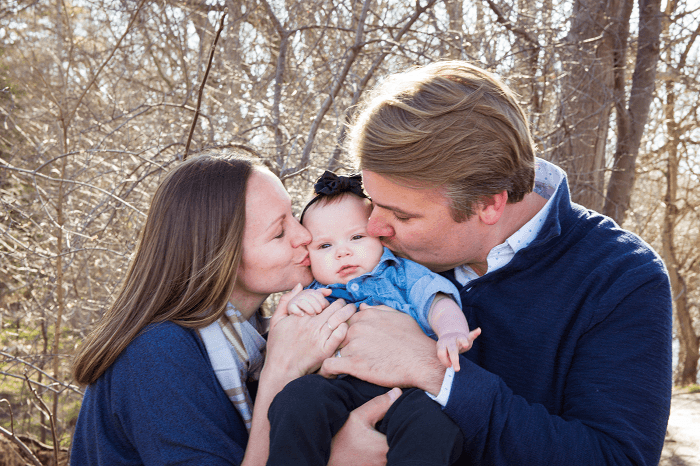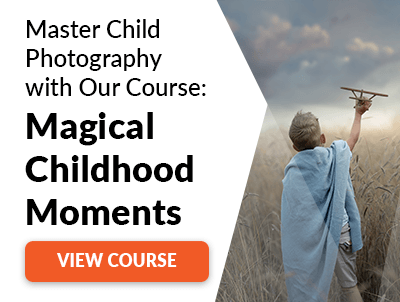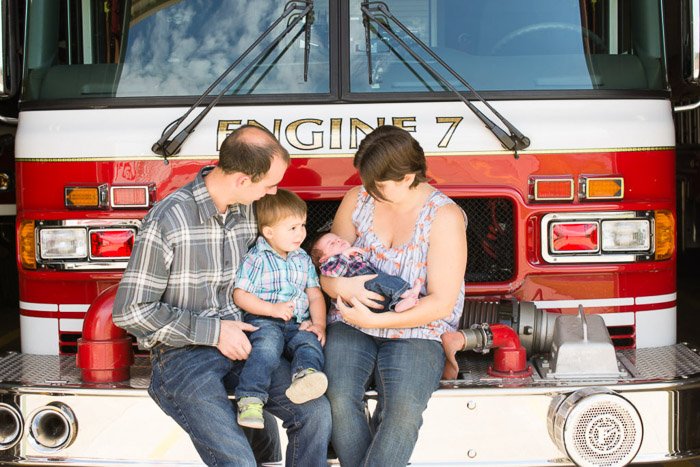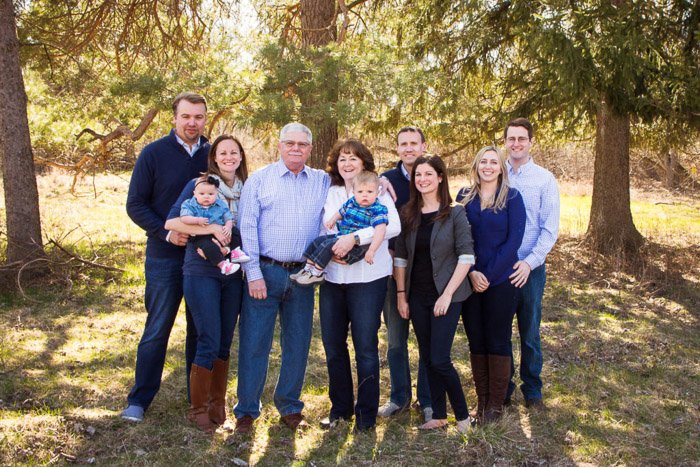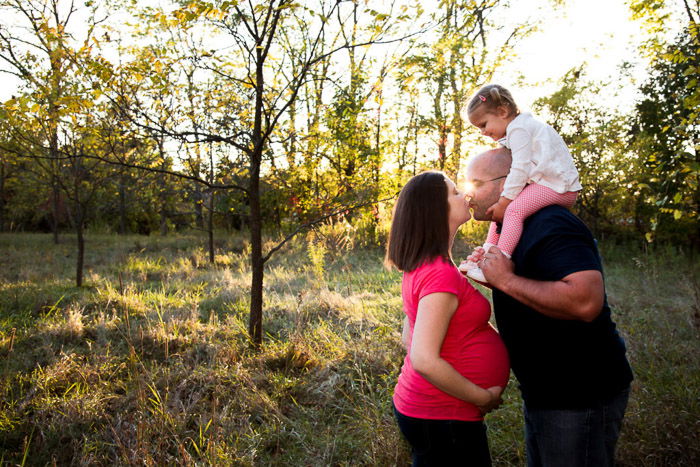Family Photography Gear: The Camera
The best camera for family photography mixes both resolution and moderate speed. Resolution, for capturing those details. And speed? Because you’ll often be photographing kids that have a hard time sitting still. You don’t need the crazy double digit speeds of a sports camera, but you should at least have a 5 fps burst speed. Interchangeable lens cameras are ideal for photographing families. But choosing between mirrorless and DSLRs is a matter of personal preference. Both have great image quality and performance. And both can easily meet the needs of a professional family portrait photographer. Full frame cameras will offer the most quality. But a crop sensor DSLR or mirrorless is still a solid camera for photographers with limited gear budgets. Just remember, if you decide to upgrade later, you’ll also need to upgrade to full frame lenses. This is only the case if the lenses you choose are for crop sensors. Finding a solid interchangeable lens camera with good resolution and decent speed isn’t tough. Here are a few excellent options currently on the market:
Nikon D850 Nikon D7500 Sony a7 III Sony a7R III Fujifilm X-T2 Fujifilm X-T20 Canon EOS 5D Mark IV Canon EOS 6D Mark II Olympus OM-D E-M1 Mark III Panasonic G9
What’s the Best Lens for Family Portraits?
A good camera needs good glass to match — so what is the best lens for family portraits? There are several things to look for in a good family portrait lens — and you may want to pick up more than one.
Zoom or Prime
A zoom lens isn’t a requirement for family photography. Just zoom with your feet. That doesn’t mean there aren’t benefits to a zoom lens. It can help you capture a greater variety of poses faster than a prime lens. This is a big help when working with young kids that only have so much patience for photos. Prime lenses tend to have wider apertures. You won’t use an f/1.8 photographing a large group, or most of the faces won’t be in focus. But, you might use that wide aperture photographing just mom and dad. Or to intentionally focus on only one member of the family. A bright prime lens also tends to sell at a much lower price point than a bright zoom lens.
Wide Angle Lens
Families can be as small as two people — or they can push upwards into double and triple digits. For photographing larger families, you’ll need a wide angle lens to fit them all in. You don’t want a crazy wide angle lens, or you’ll end up with too much distortion. A 35mm is a good length for capturing the entire family, either within a wide-angle zoom or as a 35mm prime lens. Try:
a 35mm f/1.8 prime lens a 24-70mm f/2.8
Standard Telephoto Lens
Wide angle lenses will be sure to fit everyone. But longer lenses tend to be more flattering for portraits. A standard or shorter telephoto lens like a 50mm or 85mm is the most common. You can still use shorter telephotos and a standard focal length like a 50mm. You’ll need a wide open space to stand farther back when photographing larger groups. This is why many family portrait photographers will still have a wide angle. It’s for those times when they can’t stand that far back from the subjects. Try:
An 85mm f/1.8 prime lens A 50mm f/1.8 prime lens A 70-200mm f/2.8 zoom lens
Family Portrait Lighting With Flash
A flash can make a significant impact on your work. Some family portrait photographers use all natural light. But sometimes, natural light won’t give you the best result. That’s where flash comes in. Unlike studio lights, a flash is easy to bring on location. You can use one whether you’re photographing families in a park or shooting lifestyle family photos indoors. The easiest (and maybe even best) way to use a flash is to create catchlights in the eyes. All you need is a flash with a diffuser left on a low manual setting. This means the existing light won’t be affected much at all. Flash can also add interest to a shot, prevent you from blowing out the sky in the background and so much more. The good news is that you don’t need the most expensive flash for shooting a family portrait. The priciest flashes will reach farther and overpower the sun. But since you’re (probably) not using a 300mm lens for family photography, that expensive flash is overkill. Look for a flash that has manual controls. A range between 1/1 and 1/128 is great for family portraits. The flash should also have an adjustable tilt to bounce it. Look at the specs for the zoom range, and make sure that the range covers the lenses that you use. Most flashes should cover the typical lenses used for family portraits. Try:
Canon Speedlite 430EX III-RT Nikon Speedlight SB-700 Phottix Mitros+ TTL Transceiver Flash
Flash Modifier
The key to using flash and actually liking the results is to “clothe” your flash. Avoid shooting with a naked flash. A flash diffuser will soften the light. It’ll make it look like a flash wasn’t used at all while still offering the benefits of using one. Flash diffusers come in different types. The key is to get something that’s actually larger than the flash head itself. You can pick up a basic flash soft-box for around $20, or use something like the MagMod diffuser. This is my personal choice. It never falls off the flash like the cheaper soft-boxes have a tendency to do. An alternative to diffusing the flash is to bounce it. Flash bounce cards allow you to bounce a flash even when you’re not close to a wall. It creates a similar softer light. And it eliminates those harsh shadows that make it obvious even to non-photographers that you used a flash. Another helpful flash accessory are gels. Gels will change the color of your flash. I often use an orange flash gel to create a more golden light that looks closer to a golden hour sun. Try:
MagMod diffuser and colored gels Rogue Flash Bender
Off-Camera Flash
Some flashes have this capability built in, like the Phottix flash above. All you need is a transmitter or a second flash to use as a transmitter. But many of the more budget-friendly flashes don’t have the capability built-in. Taking the flash off camera allows you to create studio lighting effects anywhere. It creates more depth to the image than on-camera flash by creating soft but visible shadows. Flash transmitters, like lenses, are designed to work with a specific brand of flash. Make sure you pick up a compatible set. Try:
Phottix Strato II receiver and transmitter set
Tripod
Unless you happen to work with an assistant, you’ll need a spot to put that off-camera flash. Tripods will do the trick, and unlike a light stand, you can also use it to hold your camera if needed. The best tripods for family photography will be portable but sturdy options. They’re similar to what wedding photographers look for in a tripod. Family photographers typically don’t need a tripod for the camera. This is because of the fast shutter speeds. Some kids and even adults can be intimidated by the camera, however. Leaving it on a tripod and using a remote to snap the photos, is an option. Try one of the tripods on this list.
Camera Bag
Pick up a camera bag with padded dividers for your camera, lenses, flash and other accessories. Backpacks are more spacious and the double straps can be more comfortable. Shoulder 3-point slingers and sling-style bags tend to be more stylish and offer faster access. The options for great camera bags are even wider than the number of great cameras out there. Here are a few suggestions. Along with protecting gear with a proper bag, don’t forget to pick up the essentials for keeping lenses and the camera clean.
Small Accessories for Family Portraits
Sure, the camera, lenses and lighting gear are some of the most expensive items that you’ll need to buy, but there are a few smaller essentials too. When setting your family photography equipment budget, don’t forget to factor in:
Memory cards: Choose something that’s a Class 10 or better to keep up with RAW burst shooting. Batteries: Make sure you have enough batteries for both the camera and the flash. Protective lens filters: Keep your lens from scratches with a UV filter. Reflectors: Reflectors aren’t large enough for big groups, but you can use one for taking individual portraits of each family member or for families of 2-3 people.
Non-Photo Accessories for Family Portraits
I also bring along some non-typical accessories that you wouldn’t pick up at a photo store. These items may not be necessities. But they can add variety and make it easier to get smiles out of the littlest subjects. I usually bring along a few “smile items” that most kids tend to go crazy for. For kids a year old and younger, a musical toy can help get them to look in the direction that you’d like them to. The more enjoyable the photo experience is for the kids, the better the results. Depending on the location, I may also bring along a few simple props. A picnic blanket is nice for posing variety, for example. And don’t laugh, but on many shoots, I bring a step stool so I can get a greater variety of angles during the shoot. Getting higher up can help fit more people into a large group, and allows me to play with perspective. That’s a lot of gear — so how do you carry it all? On small shoots, I can fit everything in a backpack and carry a flash-tripod combo. When I need to grab everything, I use a folding wagon.
Conclusion
With any photography gear, it’s important to find a balance. You want to enough gear to get the shot but not so much you can’t actually bring it all to the shoot. The gear you need will also vary based on your style and budget. Photographers with a light and airy style, for example, don’t use a fill flash. Start with a good camera and a lens or two. Then expand with lighting gear, extra lenses and other accessories as you find your style. If you’re in doubt about what to buy, try renting equipment. This is helpful for trying out the most expensive family photography equipment. Next, why not check out our picks for best Nikon portrait lens!
